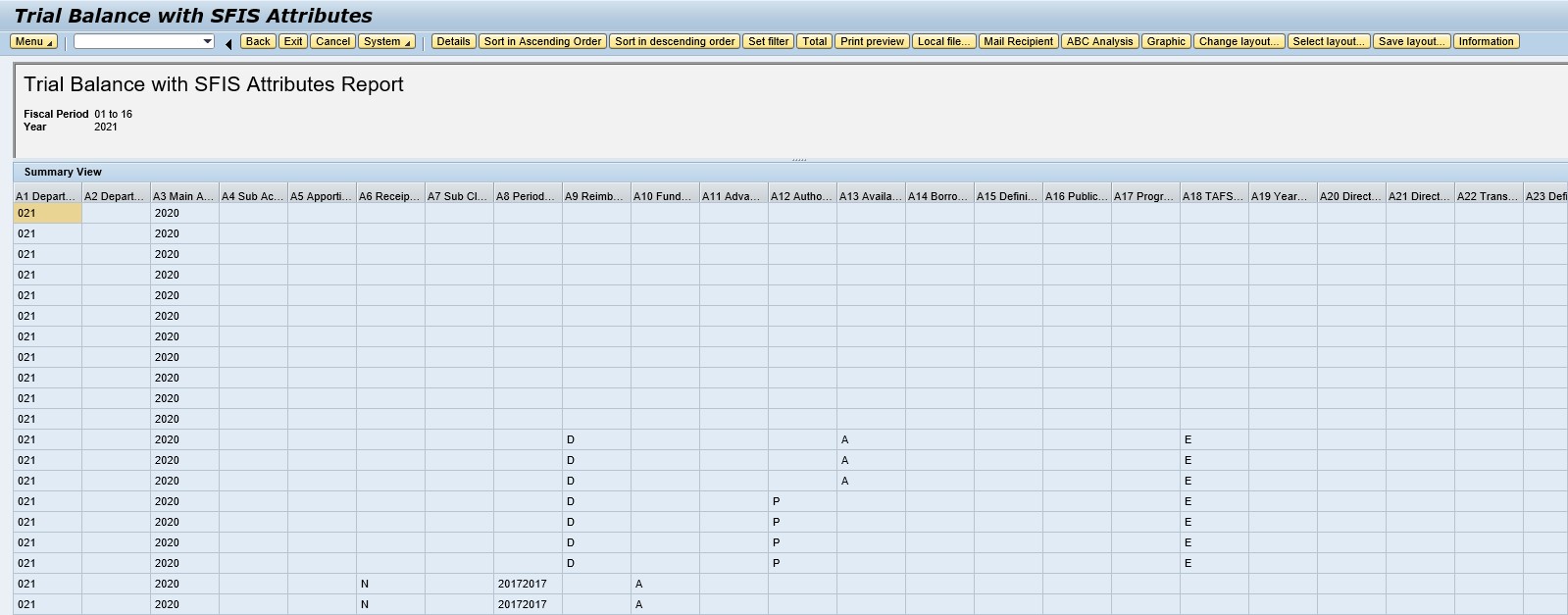
FINANCIAL
MANAGEMENT SCHOOL
GFEBS L413E Financial Management
Summary
This concludes the Generated Reports module. In this module, we covered key reports populated with transactional data used to create financial statements, transaction codes for the reports, and provided a defined purpose.
You now should be able to:
- Define the purpose of generated reports
- Identify specific reports
- Describe the forwarding procedures for generated reports
You may exit this module by clicking the Exit button

Welcome to Financial Reporting
Welcome to Generated Reports. In this module we will discuss multiple reports used to create financial statements used to interpret transactional data. This data is used to decipher the financial health of the Department of Army.
Lesson Objectives
After completing this lesson, you will be able to:

Key Terms
G/L Account Balances Report
Use the G/L Account Balances Report to investigate account balance details. It lets you view credit and debit amounts, and total debit and credit amounts, of a range of G/L accounts during a specific period.
Transaction Code (T Code): F.08

Abnormal Balance Report (1 of 5)
The Abnormal Balance Report is used by the FI business process area during the Period-End and Year-End Close processes to identify and review G/L accounts that have abnormal balances.
An account has an abnormal balance when:
- It is a type that should post a debit balance, but it posts a credit balance instead
- The account is a type that should post a credit balance, but it posts a debit balance instead.

Abnormal Balance Report (2 of 5)
The normal balance for each USSGL account is determined by Treasury and is pre-programmed in GFEBS. This report checks the balance of each G/L account and compares it with the balance of the corresponding USSGL normal balance. The report then identifies which G/L accounts do not match their expected balance.
Transaction Code (T Code): ZSFI_ABMORMAL_BALRPT

Abnormal Balance Report (3 of 5)
The Abnormal Balance Report can be run for any of the following:
- A specific fund
- By installation
- By appropriation

Abnormal Balance Report (4 of 5)
Research the abnormal balances identified in this report to ensure the abnormal balance condition is a result of valid transactions. To do this, you can drill down on the abnormal balance line item to display and view details like:
- G/L Account
- Document Number
- Fund
- Application of Fund
- Company Code
- Transaction Amount

Abnormal Balance Report (5 of 5)
The Abnormal Balance Report can also be run at the following levels:
- G/L Summary Level
- Detailed G/L Account Level

Federal Transaction Register Report (1 of 3)
Use the Federal Transaction Register Report to review all credit and debit postings in GFEBS. A transaction register captures data at a document and line item level for all financial postings to the General Ledger. The report lists which fund, fund center, commitment item, and accounts a transaction is posted to in GFEBS.
Transaction Code (T Code): FMFG_E_TRANS_REG

Federal Transaction Register Report (2 of 3)
The Federal Transaction Register Report lists the following for financial documents that are posted in GFEBS:
- Fund
- Fund center
- Commitment item
- Account number

Federal Transaction Register Report (3 of 3)
Report Filters
When running this report, you have the flexibility to view transactions associated with:
- A specific fund
- A fund center
- A commitment item
- A particular G/L account
This report is also a drill-down report, which allows you to double-click on the line item to view detailed information about the financial document.

Line Item Reports (1 of 3)
A line item is the part of a financial document in GFEBS containing accounting and transaction amount information about a single item. It includes:
- The amount
- An account number
- The assignment to debits or credits
- Additional specifications that depend on the business transactions that were posted

Line Item Reports (2 of 3)
Line item reports allow you to search by line items for open or cleared line items, depending on which type of line items you want to view. The report pulls the appropriate line items, depending on the selections you specify on the initial screen. The three main line item reports used by the FI business process area are:

Line Item Reports (3 of 3)
The G/L Account Line Item Report shows all the G/L account line items that are open, cleared, or posted, depending on specifications. Similarly, the Vendor Line Item Report and Customer Line Item Report show vendor and customer line items, respectively, which are open, cleared, or posted.

Line Item Reports and Cash Balancing (1 of 3)
The FI business process area uses all three of these line item reports during the Cash Balancing process. When GFEBS receives Defense Cash Accountability System (DCAS) inbound files containing cash transactions to be posted in GFEBS, the interface automatically matches transactions to their corresponding entries and clears them. The GFEBS interface also posts any transactions that do not have a match as "unmatched transactions."

Line Item Reports and Cash Balancing (2 of 3)
To view the documents posted as unmatched by this interface, the Cash Balancing Processor runs the G/L Line Item Report and searches the line items by "document type." To find a match for the document, the Cash Balancing Processor then runs the Vendor or Customer Line Item Report, depending on whether a matching vendor invoice or customer bill is required. By running this additional line item report, required. By running this additional line item report, the Cash Balancing Processor required. By running this additional line item report, can view open items that may be a possible match for the unmatched G/L document.

Line Item Reports and Cash Balancing (3 of 3)
To view the documents posted as unmatched by this interface, the Cash Balancing Processor runs the G/L Line Item Report and searches the line items by "document type." To find a match for the document, the Cash Balancing Processor then runs the Vendor or Customer Line Item Report, depending on whether a matching vendor invoice or customer bill is required. By running this additional line item report, theCash Balancing Processor can view open items that may be a possible match for the unmatched G/L document.

Treasury Report on Receivables (1 of 3)
The TROR is a report that the U.S. Treasury requires from U.S. Government agencies to provide a status of debt due from the public. It serves as a management report that informs Federal decision-makers of the gross book value of the receivables owed to Federal agencies, and the status of the Federal Government's debt portfolio. The figures provided in the TROR reconcile with each agency's financial statements for the month.

Treasury Report on Receivables (2 of 3)
All DoD agencies are required to provide the data required for the TROR report to DDRS at the end of each month. In GFEBS, the data required for the TROR is sent to DDRS via the TROR interface. The Financial Reviewer can manually execute this interface, or it can be scheduled to run each month at a certain date and time. The External Information Monitor is responsible for making sure this interface is sent on time. DDRS takes the TROR data it receives from each Defense Agency and consolidates it into a single TROR for Treasury at the end of each period. DDRS also generates the Monthly Receivables Data (MRD) report using the data included in the GFEBS TROR. The MRD shows receivables by category and age.
The information contained in the TROR and Debt Collection Activities is sent to Congress, the Office of Management and Budget (OMB), agency Chief Financial Officers, other officials and representatives of Federal and state organizations, concerned private sector organizations, and the public.

Treasury Report on Receivables
(3 of 3)
Note: In GFEBS, there are two TROR reports. The first is the Standard TROR report included with GFEBS. The second is a TROR reporting interface developed specifically for GFEBS. This custom TROR report structures TROR data according to DDRS reporting requirements.
Although the custom TROR report is the version sent to DDRS via interface, you may need to run the standard TROR report to validate the data in the custom TROR interface and reconcile differences. This course will teach you to run the Custom TROR reporting interface. If you are the Financial Reviewer and need to run the standard TROR report for validation purposes, use the Treasury Report on Receivables Online Help Procedure. It provides detailed work instructions for running the report.

Trial Balance in GFEBS (1 of 4)
Recall that GFEBS does not create its own financial statements. Instead, it sends a Trial Balance to DDRS, which then produces the Army's financial statements for the period.
The GFEBS Trial Balance reflects the complete financial picture for Army general funds. To provide complete information for the entire Army, information from other sources, such as inventory management, property management, and Army investments are retrieved/interfaced to GFEBS to update and support the Trial Balance.

Trial Balance in GFEBS (2 of 4)
The Trial Balance is segmented into two separate reports with different transactions codes. The following highlights the differences:
The Trial Balance by Fund at the SGL Account Level which does not include SFIS attributes.
Transaction Code (T Code): ZSFI_DDRS_TRL_BAL
The SFIS Trial Balance, a trial balance which incorporates SFIS attributes.
Transaction Code (T Code): ZSFI_SFISREPORT

Trial Balance in GFEBS (3 of 4)
Trial Balance at the Full Account Level:
This Trial Balance includes the balances for all of the Army's point accounts. For instructions on running this trial balance, reference the Trial Balance by Fund at the Full Account Level Online Help Procedure. This will walk you through each step involved in running this Trial Balance at the GFEBS Full Account Level (i.e. 4.4, eight-digit level).
The DDRS Outbound Trial Balance:
This Trial Balance includes Defense Reporting Elements (DRE). This Trial Balance with Defense Reporting Elements (DRE) is a subset of SFIS. This Trial Balance is sent via interface to DDRS at the end of each month to report the Army General Fund financial status. Refer to L414: Period-End Closing and L415 Year-End Closing for detailed information on executing the interface that sends this final Trial Balance to DDRS.

Trial Balance in GFEBS (4 of 4)
After the closing activities in the Period-End and Year-End processes are complete, the Financial Reviewer runs the Trial Balance by Fund at the SGL Account Level to see if all ending account balances add up to zero. If the net balance of the Trial Balance by Fund at the SGL account level is not zero, the out of balances must be researched and corrected. The Trial Balance by Fund at the SGL Account Level shows the balances of the four-digit SGL accounts.
If necessary, the Financial Reviewer may also run the SFIS Trial Balance to show the fund balance by SFIS attribute.
If the net balance of the SGL Trial Balance is zero, the External Information Monitor runs the DDRS outbound interface, which sends the final Trial Balance with Defense Reporting Elements (DRE) to DDRS. If the net balance of the SGL Trial Balance is not zero, the out of balances must be researched and corrected. The net balance of the SGL Trial Balance must be zero prior to sending the final Trial Balance to DDRS.
DDRS Produced Reports and Statements
With the GFEBS Trial Balance, DDRS produces the following reports for the Army:
AFS (Audited Financial Statements)
- Balance Sheet
- Statement of Net Cost
- Statement of Changes in Net Position
- Statement of Budgetary Resources
- Variance Reports
Budgetary Reports
- SF133 Report on Budget Execution and Budgetary Resources
- FMS 2108 Year-end Closing Statement
- AR(M) 1307 Cash Flow, Financial Position
- AR(M) 1002 Report on Appropriation Status by Fiscal Year Program and Sub-accounts
- AR (M) 725
- SF 132 Apportionment and Re-apportionment Schedule
- Treasury Report on Receivables
- Monthly Receivable Data (MRD)
- FACTS II Exports
- BEX Exports
Check on Learning
Summary
This concludes the Generated Reports module. In this module, we covered key reports populated with transactional data used to create financial statements, transaction codes for the reports, and provided a defined purpose.
You now should be able to:
- Define the purpose of generated reports
- Identify specific reports
- Describe the forwarding procedures for generated reports
You may exit this module by clicking the Exit button

Welcome to Financial Reporting
Welcome to Generated Reports. In this module we will discuss multiple reports used to create financial statements used to interpret transactional data. This data is used to decipher the financial health of the Department of Army.